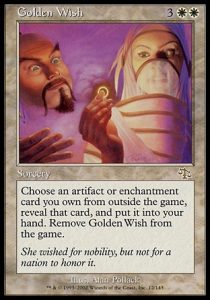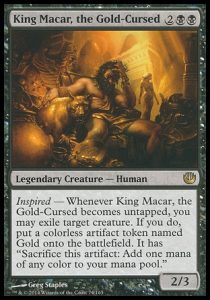The Golden Rules of Magic
Alrighty, so first off we start with perhaps the most basic question in Magic. What are you supposed to do when a card’s text contradicts the game rules you spent all that time learning?
 Luckily that basic question has a very simple answer, which turns out to be the first of our 4 Golden Rules of Magic. CR 101.1 tells us “Whenever a card’s text directly contradicts these rules, the card takes precedence. The card overrides only the rule that applies to that specific situation.”
Luckily that basic question has a very simple answer, which turns out to be the first of our 4 Golden Rules of Magic. CR 101.1 tells us “Whenever a card’s text directly contradicts these rules, the card takes precedence. The card overrides only the rule that applies to that specific situation.”
As a follow up to that, we asked what would happen if a player tried to concede the game while their opponent controlled an Abyssal Persecutor? After all them losing the game would violate Persecutor’s text, and we just said cards trump rules right?
- Luckily, no one has to worry about getting stuck in a game they have no desire to play, as the last part of CR 101.1 includes an exception for concessions. Interestingly, this may be the only time where a card’s rules don’t out rule the base game’s rules.
Golden Rule 1 told us what happens when a card and the game decide to butt heads, but what about when two cards ask us to do mutually exclusive things? For example a Standard Bearer with a Whispersilk Cloak on him?
- This question produced some interesting discussion. As it turns out, the people who make Magic have been doing a really good job making sure that the wording on cards helps make the rules more intuitive. So nowadays, most cards that say we “must” do something include an “if able” so that people understand that if it isn’t possible it’s ok. But CR 101.2, aka Golden Rule Number 2 had our back even back in the days before this better wording by letting us know “When a rule or effect allows or directs something to happen, and another effect states that it can’t happen, the “can’t” effect takes precedence”. So putting a Pacifism on a Crazed Goblin doesn’t create some crazy superposition of attacking and not attacking.
Golden Rule 3 turned out to be foreshadowed in our Standard Bearer example from earlier. The question was asked how a card like Innocent Blood would resolve or could it be cast if only one player controlled creatures. This turned out be be similar to earlier when it was asked if we could still casts a Doom Blade even with a shrouded Standard Bearer on the opponent’s board.
- Golden Rule 3 rides in here to save the day as CR 101.3 tells us that if part of a card’s instructions can’t be done, you simply ignore it. This doesn’t mean that you can cast illegal spells but simply ignoring the parts you can’t do, but it does mean that you can still throw Doom Blades all willy nilly if those pesky Standard Bearers suit up.
Our final Golden Rule was actually alluded to during the discussion for Rule 3, as it was mentioned that during the resolution of an Innocent Blood, the active player would have to make their choice first. This basically spelled out CR 101.4 which is commonly referred to as the APNAP rule. Included in this rule is the fact that when making their choices in this order, players are entitled to all choices made earlier in the APNAP order. But what would happen if those choices were being made from a hidden zone, like in the case of Show and Tell?
- Hidden zones remain aptly named, even during APNAP choices thanks to CR 101.4a, which adds an exception for choices made from hidden zones. So long as the card(s) chosen are clearly indicated face-down, the hidden information can be preserved until all players have chosen.
While talking about the ordering of choices, what about cards that ask us to make a whole slew of them at once? Surely our Golden Rules have something to say about that?
 Once again this falls under rule 101.4, specifically part C, which tells us that whenever a card gives us instructions, we have to do them in the printed order. So if all you have is lands and a Dryad Arbor when your opponent casts Smallpox, you’re in for a bad time. Once again, the answer of “do things in the order it says to do them” may seem quite simple, but without formal rules to lay that out we open the door for all kinds of wacky worlds.
Once again this falls under rule 101.4, specifically part C, which tells us that whenever a card gives us instructions, we have to do them in the printed order. So if all you have is lands and a Dryad Arbor when your opponent casts Smallpox, you’re in for a bad time. Once again, the answer of “do things in the order it says to do them” may seem quite simple, but without formal rules to lay that out we open the door for all kinds of wacky worlds.
Wrapping things up we hit on the last part of Golden Rule 4, CR 101.4d, which covers the uncommon scenario where a player making their choices in APNAP order causes a player(s) earlier in the order to make choices. While this may seem inconsequential, the information could influence later players and so it’s important to know when those sorts of decisions have to be made. Our example involved a Thieves’ Auction and a whole bunch of Archangel of Strife.
- CR 101.4d lays out a way to resolve these fairly complex scenarios. Anytime a new set of choices has to be made in the middle of APNAP order choices, we simply reset to active player, make all the new choices in APNAP order, and then go back to where we were in the order when the new choice started. Almost like starting a sub game of Magic. Only instead of getting caught in 1001 nights of Shahrazad, the players just make their choices and move on.
Further Reading:
-The Golden Rules: CR 101
Related Articles:
–Golden Rules
